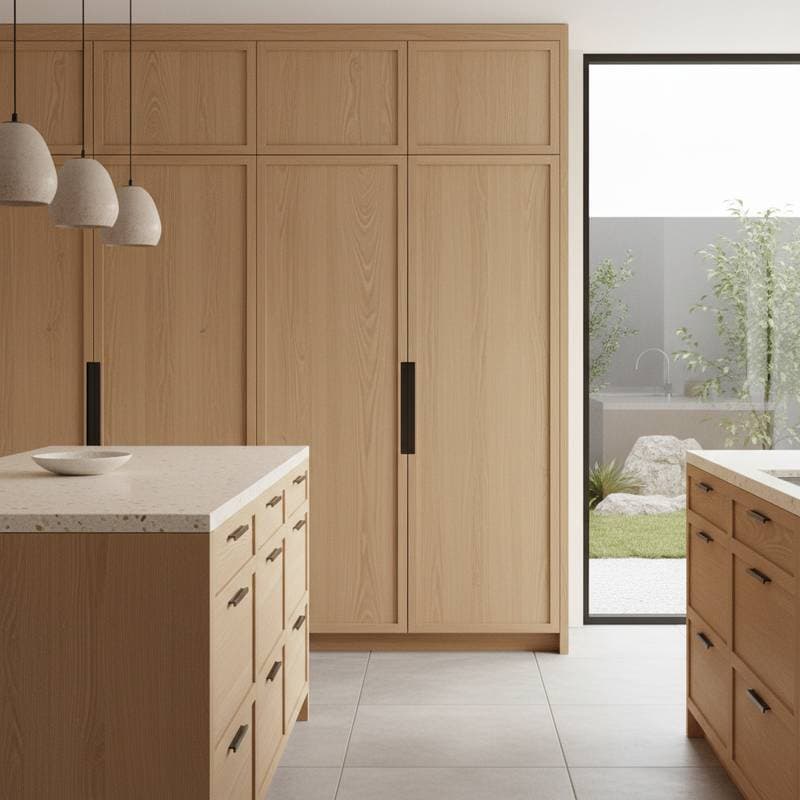Why Minimal Hardware Elevates Japandi Shaker Cabinets
Swapping out outdated cabinet pulls represents a subtle yet impactful decision that reshapes the appearance of a kitchen or bathroom. Homeowners embracing Japandi Shaker cabinets discover that restraint holds the key to success. Minimal hardware extends beyond mere simplification; it influences the ambiance, utility, and longevity of the space. This approach merges serene modern contours with enduring artisanal quality, while managing expenses and upkeep effectively.
The Balance of Japandi and Shaker Design
Japandi Shaker cabinets fuse two distinct design philosophies. Shaker heritage prioritizes straightforward construction and harmonious proportions. Japandi aesthetics enhance this foundation through organic materials and tranquil minimalism. Minimizing visible hardware intensifies these core attributes.
Subtle pulls or concealed finger pulls preserve seamless surfaces. The wood's grain emerges as the primary focus, rather than metallic highlights. In compact kitchens, this approach creates an illusion of height and clarity. In expansive areas, it sustains a cohesive flow along extended cabinet lines, free from disruptive details.
Key benefits:
- Reduced interruptions direct attention to the wood's texture and precise joinery.
- Uniform light diffusion across smooth panels accentuates inherent hues.
- The lack of prominent metal elements aligns with Japandi's peaceful vibe.
Practical tip:
Remove a single handle from a lower cabinet. Observe the result from a distance. If the door's form holds its integrity without added decoration, the design suits minimal hardware.
Cost and Budget Planning
Standard minimal hardware pieces range from $2 to $8 each. A kitchen requiring 30 pieces incurs costs of $60 to $240. Opting for premium options like solid brass or custom wood pulls raises the figure to $300 to $350. Professional installation contributes an additional $100 to $200.
Influencing factors:
- Selection of material, whether metal, wood, or composite.
- Durability of the finish and applied protective layers.
- Customization for embedded grips through specialized milling.
- Time invested in accurate placement by skilled labor.
Choosing minimal hardware decreases overall expenses by limiting material needs and installation duration. Savings typically reach 20 to 30 percent relative to elaborate decorative sets.
Budget tip:
Source hardware in volume from a single supplier. Inconsistent finishes not only disrupt harmony but also complicate future replacements, inflating long-term costs.
DIY or Professional Installation
Homeowners with essential tools and steady hands complete minimal hardware installation in a single day. A skilled professional accomplishes the task in half that duration, though at extra expense.
Essential DIY tools:
- Drill equipped with a depth stop.
- Measuring tape paired with a level.
- Template for uniform hardware placement.
- Soft cloth to safeguard surface finishes.
Scenarios favoring DIY:
- Cabinets feature pre-drilled holes or existing pull replacements.
- Hardware employs standard screws without need for recessed cuts.
Instances requiring professional expertise:
- Preference for grips milled directly into door edges.
- Presence of delicate custom finishes prone to damage.
- Desire for precise alignment across extensive cabinet arrays.
An experienced cabinetmaker employs a router and jig to craft recessed grips in approximately one hour per segment. Such accuracy guarantees even edges and uniform depth, essential for achieving the refined minimalist profile.
Hiring guidance:
Confirm the installer's liability insurance and review references from comparable installations. Request sample panels demonstrating edge-pull fabrication prior to committing to the full project.
Living with Your Design
Minimal hardware endures gracefully, spotlighting artisanal details over fleeting fashions. Compact knobs facilitate straightforward swaps should preferences evolve. Integrated pulls demand greater attention but withstand decades when sealed appropriately.
Routine maintenance:
- Clean weekly using a damp microfiber cloth.
- Steer clear of harsh chemicals that diminish luster.
- Secure screws biannually.
- Apply oil annually to wood grips for humidity resistance.
This design choice diminishes distractions, allowing appreciation of the wood's tactile quality, shifting light patterns, and nuanced grain variations. It integrates seamlessly into modern or classic settings without strain. The result offers adaptability for subsequent updates or property sales.
Record-keeping tip:
Compile a dedicated folder with hardware details, including supplier information, finish designations, and screw dimensions. This organization simplifies any future matching or additions.
Making It Your Own
Embarking on a remodel warrants a measured start. Update the hardware on a single drawer section and assess the change over a week. Evaluate its influence on everyday interactions. If the shift enhances comfort, apply the approach throughout the space.
